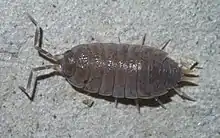Porcellionides pruinosus
Porcellionides pruinosus is a cosmopolitan and detrivorous woodlouse that is native to Europe,[2] and is suspected to consist of very closely related species. Ten subspecies are recognised.[1] The species carries Wolbachia endosymbionts, which is an alpha-proteobacterium that is known to modify the reproduction of their crustacean hosts by inducing cytoplasmic incompatibility or feminisation.[3]
| Porcellionides pruinosus | |
|---|---|
 | |
| Scientific classification | |
| Domain: | Eukaryota |
| Kingdom: | Animalia |
| Phylum: | Arthropoda |
| Class: | Malacostraca |
| Superorder: | Peracarida |
| Order: | Isopoda |
| Suborder: | Oniscidea |
| Family: | Porcellionidae |
| Genus: | Porcellionides |
| Species: | P. pruinosus |
| Binomial name | |
| Porcellionides pruinosus | |
Porcellionides pruinosus as a pet
Since it is easy to keep, the species is bred as a food source for pets or as a pet itself. There are now numerous color forms such as "Orange", "Powder Orange", "White Out", "Oreo Crumble", "Red Koi", "Powder Blue", and "orange cream" although this is the nominated form. Some cultivated forms are traded for high prices by breeders.
These detrivorous isopods are relatively fast breeders and low maintenance and they prefer humid environments. They live for about one or two years.[4]
References
- "Porcellionides pruinosus". Integrated Taxonomic Information System. Retrieved October 25, 2010.
- "European distribution". Fauna Europaea. 2.6.2. August 29, 2013. Archived from the original on October 14, 2013. Retrieved October 12, 2013.
- Alice Michel-Salzat, Richard Cordaux & Didier Bouchon (2001). "Wolbachia diversity in the Porcellionides pruinosus complex of species (Crustacea: Oniscidea): evidence for host-dependent patterns of infection". Heredity. 87 (4): 428–434. doi:10.1046/j.1365-2540.2001.00920.x. PMID 11737290.
- "porcellionides pruinosus lifespan - Google Search". www.google.com. Retrieved 2023-07-23.